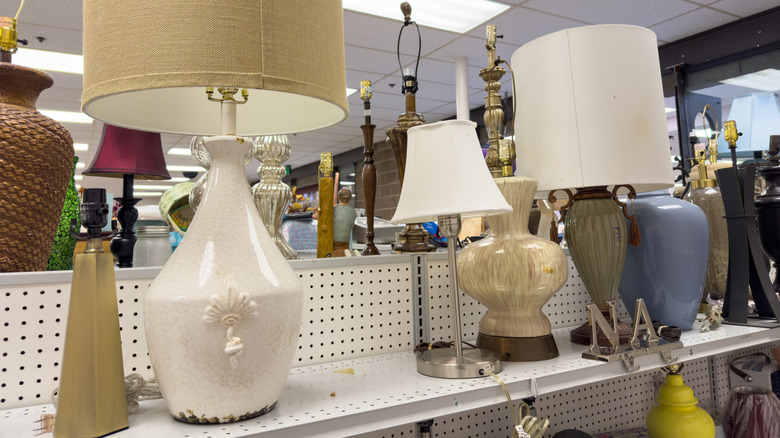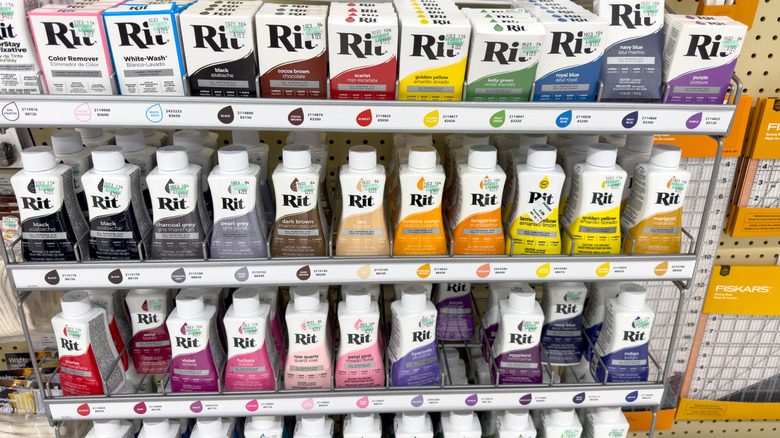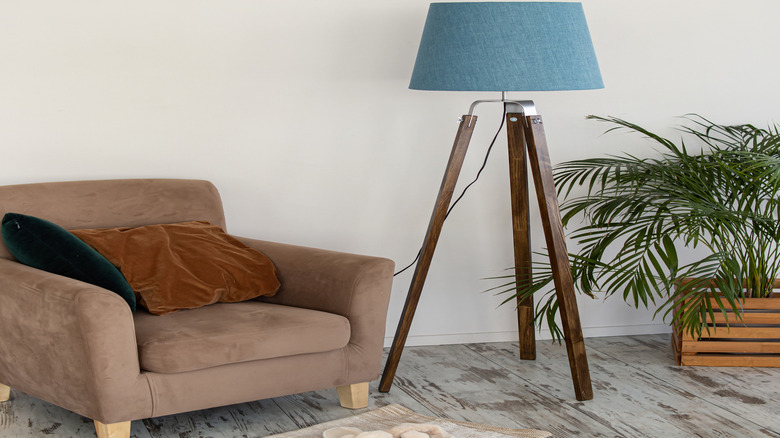Give A Thrifted Lampshade New Life With A Refresh You Can DIY
You never know what you'll find at the thrift store. Thrifting home decor is a cost-effective way to add a constant stream of new items to your house without spending a lot of money. Walk into any thrift store and you're bound to find a selection of lamps, but they're not always ready to go on display as-is. Sometimes they need a little help, whether that's a new coat of paint or changes to the shade. If you like the shape of a lampshade but you don't love the color, an easy solution is to dye it a new hue that will work perfectly with your existing decor.
Ideal candidates for the dyeing process are light-colored lampshades in neutral colors like white or off-white. The lighter base allows the color of the dye to show up well, and neutral tones won't change the appearance of the dye as much as other shade colors will. If the lampshade has a pattern, the dye might look different over those areas than it does over the solid sections.
Lampshades made from natural fabrics work best during the dyeing process as they absorb the dye well. Look for cotton, linen, and silk shades for the best results. Synthetic materials like polyester don't take traditional dye well, so skip those fabrics when choosing a lampshade to dye. You typically need to use special dye products that require high heat, which makes it difficult to use on a shade. Avoid styles with plastic liners as well.
Prepare the thrifted lampshade and dye
Thrifted lampshades are often older and could be quite dusty or dirty. Clean your lampshades before you dye them to avoid a patchy final product. You can wipe off dust and debris with a microfiber cloth or duster if the shade just needs a little cleaning. Spot cleaning dirty areas with a damp cloth is another option. If the lampshade is really dirty, you can submerge it in a tub of soapy water if the fabric is washable and the shade isn't glued together.
Grab a container that's large enough to submerge the entire lampshade. Cover your work area with an old shower liner, plastic tablecloth, or drop cloth to avoid getting the dye on other surfaces. Prepare the dye bath according to the product's instructions. You typically need to fill the container with hot water that's around 140 degrees Fahrenheit and then add the dye to the water.
You can use a single color of dye or combine them to create a new color. Certain additives enhance the dyeing process. One cup of salt added to 3 gallons of hot water for lampshades that contain cotton, rayon, or linen can enhance the color. For nylon, silk, or wool fabrics, adding 1 cup of vinegar instead of the salt has the same color-enhancing effect. To get consistent dye results, add 1 teaspoon of dish detergent to the dye bath. Use a paper towel, which responds similarly to cotton, or piece of the same kind of fabric to check the color before submerging the lampshade.
Dip dye the lampshade
For one all-over color, submerge the full lampshade in the dye bath, ensuring it stays in the dye consistently. The amount of time you leave the shade in the dye bath depends on how dark you want the color to be — the color darkens the longer you keep the lampshade submerged. Check the color periodically to see if it's dark enough.
For a two-toned shade, fill a container with the first color with the depth of the water coordinating with where you want the color on the shade. If you want the shade to be half one color and half the other, fill the container with just enough water to reach the halfway mark on the shade. Once the first half is done, drain the dye and fill the tub with the second color. For an ombre effect, dip part of the shade first, then gradually submerge more of the shade, or dip the entire shade in and slowly pull it out, leaving the end that you want darker in the water the longest.
When you're satisfied with the color, run the lampshade under cold water to remove the excess dye. Continue rinsing it until no more dye comes out of the shade. You may need to use your bathtub to rinse the lampshade so you have enough room to hold it under the water. Hang the shade up to dry completely before you use it on a lamp. You can revitalize a thrifted lamp with a simple coat of paint to pair with the newly dyed lampshade, or use the shade on a lamp you already own.


